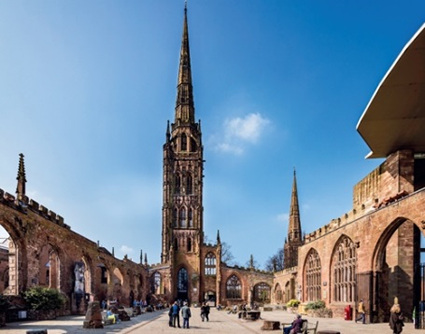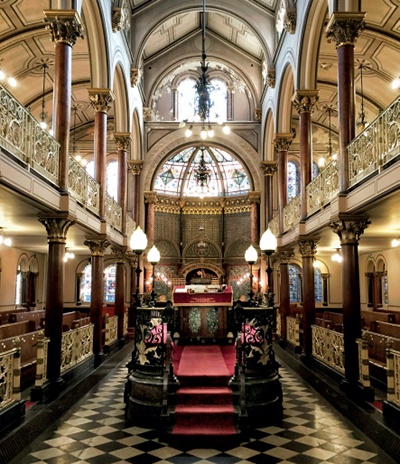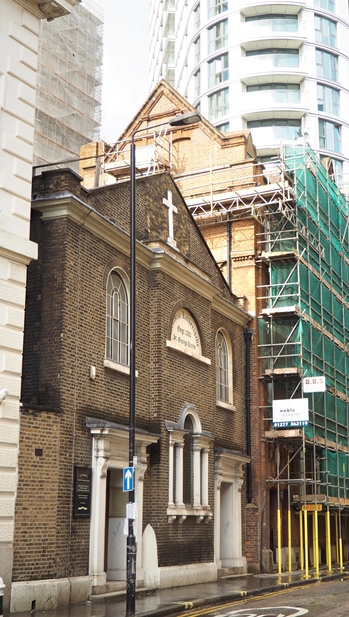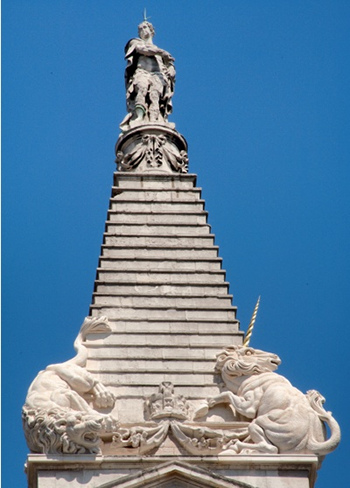To Restore or Not to Restore
John Darlington
 |
|
| St Michael’s Cathedral, Coventry: the medieval building was heavily bomb-damaged in November 1940 and its remains now co-exist with Sir Basil Spence’s remarkable modern cathedral, completed in 1957. (Photo: Jim Varney) |
My favourite heritage-related advertisement is for a castle that shall remain nameless. The over-exuberant marketing executive declares it to be ‘the most ruined castle in England’. But there are walls, doors and openings for windows… ruinous, certainly, but ‘most ruined’ requires a field devoid of anything, a blank canvas with no trace remaining of its presence.
My point is that the trajectory of the past is always towards complete ruination. Natural processes of weathering and decay play a fundamental part, but these are hastened by economic decline or growth, natural disaster, loss of relevance, apathy, even war. Churches and places of religious significance are witness to all these forces, albeit to varying degrees.
At the same time, they are hugely significant cultural markers, part of the fabric of life in the UK, whether you are a believer, an atheist or an agnostic. So the slowing down of that process of ultimate ruination, through conservation, restoration or even reconstruction, reveals a great deal about the value we place on culture.
The role of religion in shaping the landscape of today’s society cannot be overstated. In the UK nearly every village will have a church or chapel. The place-names in our countryside – glebe, kirk, capel, llan, stow – reflect that importance. Such is their ubiquity that the classic UK Ordnance Survey maps even distinguish between those with spires or towers and simple ‘places of worship’, whereas almost everything else is confined to the generic category of ‘building’.
In our larger settlements the skyline remains punctuated by the same religious landmarks, although in our biggest cities this spire-scape is becoming gradually overgrown by secular towers to white-collar industry, designer-shards or functional masts to maintain our digital habit. The diminishing visual impact of historic places of worship in the modern cityscape is a theme which this article will revisit, but suffice to say for now that these earlier buildings are critically important punctuation marks in our history.
Beyond the physical attributes of a church building, the influence of primarily Christian religious institutions in the UK is apparent everywhere, from schools, colleges and agricultural systems (for example tithe barns, or vaccary and bercary landscapes: medieval cattle and sheep farms) all the way through to courts, industrial complexes and model towns. This influence, whether current or historical, is an important part of the fabric of the UK. It contributes towards diversity and sense of place. It is part of the patina of location that makes Blackburn different from Bournemouth or Birmingham.
But, like all heritage, churches and other places of worship are on that constant path to ruination. World Monuments Fund (WMF) and World Monuments Fund Britain work to breathe new life into extraordinary heritage here in the UK and across the globe. Out of the 600 projects that WMF has worked on over the last 50 years, at least 300 have involved a church or sacred building, by far the largest percentage.
 |
|
| Middle Street Synagogue, Brighton: this magnificent Grade II* Victorian synagogue was marooned in the city centre when the Jewish community largely relocated to the suburbs. (Photo: John Darlington) |
Threats are numerous, and while some are indiscriminate in terms of the type of heritage that is affected – such as earthquakes, floods or fires – others may have a disproportionate influence, in particular the impact of conflict and the changing demography of belief, which are linked to a broader economic story.
The destruction of religious sites has been much in the news over the last few years, be it the demolition of the temples of Bal and Baalshamin in Palmyra by Daesh, or mausoleums in Mali, Shiite mosques in Mosul or Sufi shrines in Tripoli. Each in turn echoes the dynamiting of the Bamiyan Buddhas in Afghanistan by the Taliban in 2001. Too often religious sites and places of worship are under increasing pressure from those with fixed ideologies.
For some, heritage divides rather than unites and religious heritage divides more than secular. This is nothing new: in the heart of Westminster Abbey, rare 14th-century sedilia depict two magnificent life-sized paintings of kings, alongside a further two panels stripped back to the bare oak. The panels once held images of saints. We have no idea who they were because they were destroyed as ‘monuments of idolatry’ in 1644, one of countless examples from across the world and throughout recorded history of religious iconoclasm.
War and conflict take the headlines, but in reality a more common threat is from changing trends in religious belief, tethered to economics.
Middle Street Synagogue in the historic centre of Brighton is a magnificent Grade II* Victorian synagogue, constructed over 40 years from 1875 in a Romanesque revival style. The interior is sumptuous, featuring iron capitals with plants and fruit from Israel, abundant gold leaf and mosaic, stained glass, fine joinery, lincrusta wall coverings, marble, brass, stencilling, gilding, and scagliola. It represents the growing social status, aspiration and contribution of the Jewish community in Brighton in the 19th century.
According to Jewish Heritage UK, Middle Street is one of the ten most architecturally and culturally important synagogues in Britain. So why is it in desperate need of conservation and a new role? Here is a story of economic geography. Prompted by greater freedom, emancipation and tolerance in the first half of the 19th century, London’s expanding Jewish community sought new places to live and work. Brighton was a popular destination and well served by train from London’s East End. The increasing number of Jewish people settling in the town needed more places of worship, and Middle Street was Brighton’s fourth synagogue, all of them in central locations.
Fast-forward 100 years and Brighton has grown immeasurably, other synagogues have been constructed in the suburbs of the city, following in the wake of their congregations, which have relocated from the centre of town. The consequence is that there is no substantial local congregation any more for Middle Street. This, exacerbated by an absence of parking and modern facilities, has resulted in the search for a new purpose for Middle Street. It is a building marooned from its users, and the same story plays out with churches and other places of worship.
There are over 50,000 churches in the UK, 16,000 of them are listed. 1,700 churches have been made redundant since 1969, when The Churches Conservation Trust was established. And since then over 350 have been demolished. The difficulty of such a threat is that it is a slow, insidious process. A congregation rarely moves en masse, but gradually fades, and it is not until the elastic of a maintenance budget (likely to be high in the case of a historic building) finally breaks that action is taken.
In this context the research carried out by Dr Peter Brierley on the growth or decline of different Christian denominations makes fascinating reading, and broadly records which types of church are most likely to face redundancy, while pointing to future trends. The indispensable UK Church Statistics points to static church membership in England over the past decade, but this hides a growing number of new Christian denominations (340 in total in 2010 against 275 in 2005) and therefore new churches, particularly Pentecostal and new smaller denominations, at the expense of the traditional denominations, such as the Baptists, Methodists, Presbyterian and Anglican congregations.
 |
|
| A David among Goliaths: St George’s, Aldgate was built in 1763 for London’s German community. Its Lutheran modesty and simplicity, compounded by the loss of its bell-tower in the 1930s, have left it struggling to stand out among the gangling high rise development that surrounds it. |
The number of Catholic churches in England and Wales shrank from 2,813 in 2000 to 2,457 in 2010. The same pressure may be anticipated with synagogues, given that membership has declined in the UK from 110,000 members in 1983 to 83,000 members in 2010. Conversely the number of mosques has grown, with nearly 1,700 Masjids identified in 2015, while there has been a more modest growth in the number of Hindu temples.
Translate these trends into the implications for historic buildings and the prognosis is clear: an increasing number of churches and synagogues will require new, non-religious uses to survive. And of course the impact is not even – there is a significant variation, split between regions, towns, countryside and cities, mirroring broader demographic changes.
Sometimes the threat is tied to economic growth and land values, placing pressure on a church or place of worship either through the redevelopment value of the plot, or because of the knock-on impact on the style and scale of surrounding development.
St George’s, Aldgate, built in 1763 by the sugar refiner Dederich Beckmann, is the oldest surviving German church in Britain. Located in what was once known as Little Germany, on the edge of the City of London, this modest building struggles to stand out among the gangling high rise development that surrounds it. It lost its bell-tower and weather vane in the 1930s, rendering it even less distinctive than its modest Lutheran architectural ambition prescribes.
It is a David among an ever-growing number of Goliaths. The city has grown around it, changing the scale of the streetscape, so that it is in danger of becoming dwarfed. Among these giants, and without an active congregation, it is fading into the background, struggling to find a sustainable new use. Yet, inside it is stunning – a place that tells the story of German sugar refiners and a lost community. It has character and its survival is important, not least because it is something distinctive and authentic that differentiates this part of London from Hoxton, Spitalfields and other parts of the East End.
How do you resolve a problem like St George’s? Clearly, making the case against inappropriate development is part of the strategy, but more proactively, you focus on the things that make the church special and distinctive – using conservation to draw out its character and to enhance the neighbourhood. This means restoring the bell-tower and weather vane, complete with St George and his dragon, conserving the facade as well as parts of the interior and adding facilities that help the church’s viability as an event venue. Fortunately St George’s is in the good hands of the Historic Chapels Trust which is working to deliver such a plan.
This leads us neatly on to the ethical issues posed by how we deal with the aftermath of destruction through war or arrest the decay induced by the struggle to find a new economic use. This one has taxed conservationists and others for centuries.
The recent debate about reconstructing Palmyra after the demolition of selected monuments by Daesh, has stirred up memories of Arthur Evans and his highly contentious reconstruction of the Palace of Knossos in Crete. Should we leave a building or monument in its destroyed state, should we be selective in our repair, or should we reconstruct? Each approach raises both practical and ethical issues: zero intervention, after making safe, is an honest testament and marks a story.
St Michael’s in Coventry was the largest parish church in the country, becoming a cathedral in 1918. On 14 November 1940 four incendiary bombs destroyed the roof, the internal structure and all the fittings including the fine medieval misericords. Only the tower and the shell of the outer walls remained. In 1941, the Council of Coventry Cathedral elected to build a new cathedral, seeking to incorporate the remains of the medieval structure in the new building.
It wasn’t until six years later that a design was put forward by Sir Charles Gilbert Scott, but this would destroy most of what remained of the building’s medieval predecessor. It was rejected. Instead a new cathedral was approved which would combine both old and new alongside one another, complementing and respecting, rather than conflicting and dominating. Basil Spence’s remarkable new building was completed in 1957, looking out over St Michael’s – together they have become a potent symbol of the act of reconciliation.
 |
|
| Modern intervention: the lion and unicorn sculptures on the 18th-century spire of St George’s, Bloomsbury are modern reproductions of pieces which were removed in 1871. Although the designs were based on thorough research and executed by highly skilled craftspeople, any attempt to restore a historic building to an earlier point in its history is likely to attract controversy. (Photo: John Darlington) |
But there is a place for reconstruction. St George’s, Bloomsbury is a Nicholas Hawksmoor masterpiece. Completed in 1731, the rich iconography of its decoration, both inside and out, makes it one of the more eccentric churches in London. Hogarth pictures it in the background of ‘Gin Lane’, with George I atop a column looking down on the depravities below.
Part of the original design included two lions chasing two unicorns around the base of the spire – a reference to the Hanoverian and Jacobite struggle for the Crown in the early 18th century. Unfortunately, these were removed by George Edmund Street in 1871, purportedly on the grounds of health and safety (plus ça change), but in reality because they were ‘doubtful ornaments’ and too flippant for the High Church tastes of the time. They were replaced by more modest ‘knots of cloth’.
By the beginning of this century St George’s, Bloomsbury was in a dreadful state – exterior and interior stonework was in desperate need of repair and the interior space had been modified to such an extent that the original scheme was lost, with no discernible benefit to the congregation. From 2002 World Monuments Fund Britain worked with a variety of partners to reverse the decline, and to restore Hawksmoor’s original vision.
Part of that restoration was to remove Street’s dull swags and re-introduce the lions and unicorns. These completely 21st-century reconstructions were based on the best research and executed by the best craftspeople. But they are new: modern interventions on an 18th-century spire. Do they improve the church? Absolutely, they return something of its eccentric character, and they are authentic to Hawksmoor’s original.
Reconstruction is invariably a large tin marked ‘Worms. Do not open’. Which period of a building’s history are you trying to revive? Do you keep the bullet-holes, or return the masonry to a pristine, pre-conflict state? If the latter, are you sweeping history under the carpet, or restoring beauty? For me, Coventry and St George’s, Bloomsbury each offer a glimpse of how to get either approach right, being largely about the power of confident curation, based on a true understanding of the spirit of a building.
To this I’d add a final observation, which applies to conservation, reconstruction or even new build: don’t break the spell. Returning to Westminster Abbey, the dean and chapter wish to allow public access to the triforium level, giving more people a chance to stare down the nave in that classic coronation shot. To do this requires access and a new lift. One approach might have been to introduce a contemporary design to the abbey – a bold statement of 21st-century intent and a piece of architecture clearly differentiating old and new. But the danger is that the magic will be lost: a jarring note that breaks the spell of the 14th-century building, because it competes or dominates.
Thankfully, architect Ptolemy Dean will build a slender gothic tower, hidden in the folds of the building behind Poet’s Corner. It is new, but it fits with the character of the abbey, complementing rather than competing. This is not a peon against new architecture, but it is a cry for an approach that respects and builds on the character and distinctiveness of the original building. If part of that character favours bold introduction and new architecture of whatever century, then crack on, but if a building is largely medieval, then don’t break the spell…



